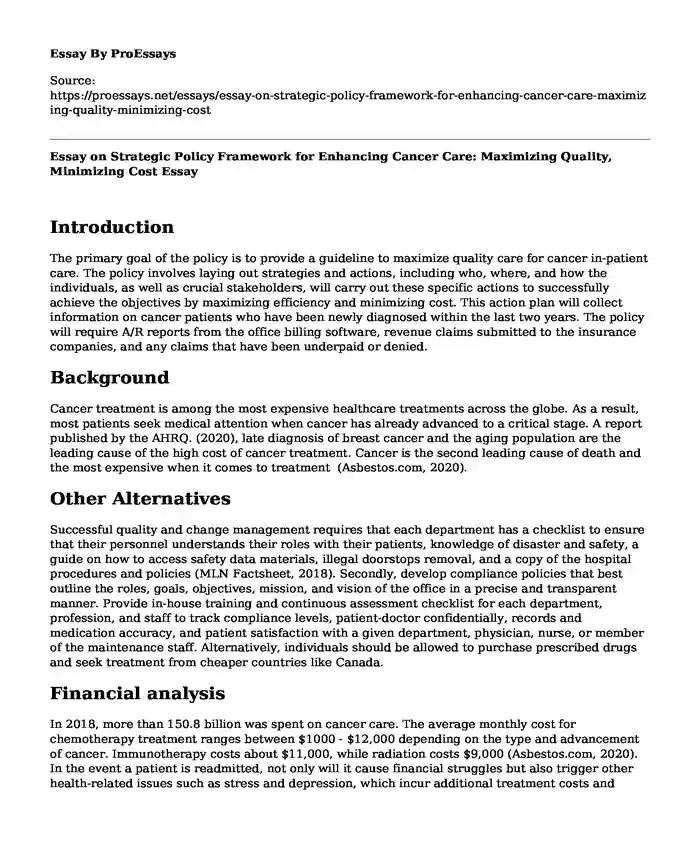Introduction
The primary goal of the policy is to provide a guideline to maximize quality care for cancer in-patient care. The policy involves laying out strategies and actions, including who, where, and how the individuals, as well as crucial stakeholders, will carry out these specific actions to successfully achieve the objectives by maximizing efficiency and minimizing cost. This action plan will collect information on cancer patients who have been newly diagnosed within the last two years. The policy will require A/R reports from the office billing software, revenue claims submitted to the insurance companies, and any claims that have been underpaid or denied.
Background
Cancer treatment is among the most expensive healthcare treatments across the globe. As a result, most patients seek medical attention when cancer has already advanced to a critical stage. A report published by the AHRQ. (2020), late diagnosis of breast cancer and the aging population are the leading cause of the high cost of cancer treatment. Cancer is the second leading cause of death and the most expensive when it comes to treatment (Asbestos.com, 2020).
Other Alternatives
Successful quality and change management requires that each department has a checklist to ensure that their personnel understands their roles with their patients, knowledge of disaster and safety, a guide on how to access safety data materials, illegal doorstops removal, and a copy of the hospital procedures and policies (MLN Factsheet, 2018). Secondly, develop compliance policies that best outline the roles, goals, objectives, mission, and vision of the office in a precise and transparent manner. Provide in-house training and continuous assessment checklist for each department, profession, and staff to track compliance levels, patient-doctor confidentially, records and medication accuracy, and patient satisfaction with a given department, physician, nurse, or member of the maintenance staff. Alternatively, individuals should be allowed to purchase prescribed drugs and seek treatment from cheaper countries like Canada.
Financial analysis
In 2018, more than 150.8 billion was spent on cancer care. The average monthly cost for chemotherapy treatment ranges between $1000 - $12,000 depending on the type and advancement of cancer. Immunotherapy costs about $11,000, while radiation costs $9,000 (Asbestos.com, 2020). In the event a patient is readmitted, not only will it cause financial struggles but also trigger other health-related issues such as stress and depression, which incur additional treatment costs and prolonged hospitalization.
Evidence-Based Recommendations
Use the HIE to provide essential data to help the management modify the policy according to both the federal and organizational benchmarks. The HIE is a vital component of the EHRs in providing essential data needed outside the clinical information to providers, and accurate EHRs offer the healthcare facility key information in providing 21st-century healthcare. Accurate HIE data play a critical role in the state and national disbursement of healthcare funds and budgeting through Medicaid and Medicare (Garg, et al., 2014).
Secondly, the hospital staff needs to adhere to the seven compliance program elements applicable to all employees. First, they should ensure they have the organization’s procedures and policies written down, comprising their compliance policy, ethics code, training plans, and recovery plans. With this, the office should have a committee and compliance officer with duly well-spelled-out roles and functions (Hodroff, 2014).
Proper training and awareness of the compliance program of the company for both new and old employees. There should be transparency in an organization where there is natural and continuous communication regarding the compliance issue with no fear of victimization (Robichau, 2014). The management should also ensure that regularly, their compliance policies are audited to ensure that they are still relevant.
References
Asbestos.com. (2020). High Cost of Cancer Treatment. Retrieved Sept 17, 2020, from Asbestos.com: https://www.asbestos.com/featured-stories/high-cost-of-cancer-treatment/
Garg, N., Kuperman, G., Onyile, A., Lowry, T., Genes, N., DiMaggio, C., . . . Jason S Shapiro. (2014). Validating Health Information Exchange (HIE) Data For Quality Measurement Across Four Hospitals. AMIA Annu Symp. Proc.. 573–579. Retrieved from https://www.ncbi.nlm.nih.gov/pmc/articles/PMC4419935/
Robichau, B. P. (2014). Breach Notification Process. Healthcare Information Privacy and Security, 171-173. doi:10.1007/978-1-4302-6677-8_19
Cite this page
Essay on Strategic Policy Framework for Enhancing Cancer Care: Maximizing Quality, Minimizing Cost. (2023, Dec 15). Retrieved from https://proessays.net/essays/essay-on-strategic-policy-framework-for-enhancing-cancer-care-maximizing-quality-minimizing-cost
If you are the original author of this essay and no longer wish to have it published on the ProEssays website, please click below to request its removal:
- Vaccine Research Paper
- Type 2 Diabetes Mellitus in an Adult Patients Case Study Paper Example
- Research Paper on U.S. Loses to Vietnam: Reasons Behind the Historic Defeat
- Science vs US Government: Essay Sample on Conflict Over Free Access to Research
- 9/11: US Policy Shifts After Terror Attack - Essay Sample
- Essay on T'Pol's Struggle with Pa'nar Syndrome: A Vulcan Taboo
- Protect Yourself and Loved Ones with Influenza Vaccination - Essay Sample







